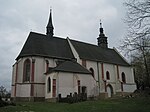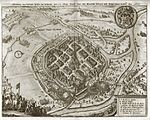Úslava
Czech Republic river stubsPlzeň Region geography stubsRivers of the Plzeň RegionTributaries of the Berounka

The Úslava is a river in the Czech Republic. It originates as the Bradlava near the village of Číhaň. It runs through the following municipalities: Plánice, Žinkovy, Nepomuk, Blovice, Šťáhlavy, Starý Plzenec, Plzeň. It empties into the Berounka in Plzeň. It is 96.3 kilometres (59.8 mi) long, and its basin area is 756 square kilometres (292 sq mi).
Excerpt from the Wikipedia article Úslava (License: CC BY-SA 3.0, Authors, Images).Úslava
Ke Svatému Jiří, Pilsen Doubravka
Geographical coordinates (GPS) Address Nearby Places Show on map
Geographical coordinates (GPS)
| Latitude | Longitude |
|---|---|
| N 49.762777777778 ° | E 13.413055555556 ° |
Address
svatý Jiří
Ke Svatému Jiří
312 00 Pilsen, Doubravka
Southwest, Czechia
Open on Google Maps










